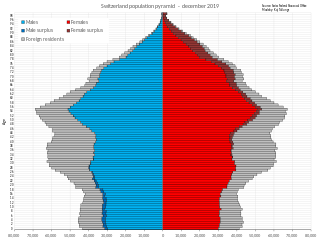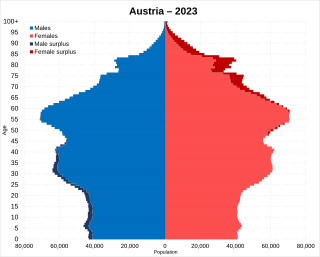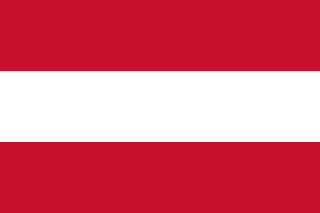Related Research Articles

Austrian German, Austrian Standard German (ASG), Standard Austrian German, Austrian High German, or simply just Austrian, is the variety of Standard German written and spoken in Austria and South Tyrol. It has the highest sociolinguistic prestige locally, as it is the variation used in the media and for other formal situations. In less formal situations, Austrians use Bavarian and Alemannic dialects, which are traditionally spoken but rarely written in Austria. It has been standardized with the publishing of the Österreichisches Wörterbuch in 1951.
Demographic features of the population of Liechtenstein include population density, ethnicity, education level, health of the populace, economic status, religious affiliations and other aspects of the population.

Switzerland has 9 million inhabitants, as of June 2024. Its population quadrupled over the period 1800 to 1990. Population growth was steepest in the period after World War II, it slowed during the 1970s and 1980s but has since increased to 1% during the 2000s.

Demographic features of the population of Austria include population density, ethnicity, education level, health of the populace, economic status, religious affiliations and other aspects of the population.
The ethno-linguistic composition of Austria-Hungary according to the census of 31 December 1910 was as follows:

A district is a second-level division of the executive arm of the Austrian government. District offices are the primary point of contact between residents and the state for most acts of government that exceed municipal purview: marriage licenses, driver licenses, passports, assembly permits, hunting permits, or dealings with public health officers for example all involve interaction with the district administrative authority.

Ballhausplatz is a square in central Vienna containing the building that for over two hundred years has been the official residence of the most senior Austrian Cabinet Minister, the State Chancellor, today the Chancellor of Austria. As a result, Ballhausplatz is often used as shorthand for the Austrian Federal Chancellery. Until 1918 the Foreign Ministry of Austria-Hungary was also housed here. Similar to Downing Street or the Hotel Matignon, the word Ballhausplatz is a synecdoche for the seat of power.

The Federal Statistical Office is a federal authority of Germany. It reports to the Federal Ministry of the Interior.
Bosnian Austrians are citizens of Austria whose ancestry can be traced to Bosnia and Herzegovina. The vast majority of Bosnians emigrated to Austria during and after the Bosnian War of the 1990s, though a large number emigrated as early as the 19th century.

A national census in Germany was held every five years from 1875 to 1910. After the World Wars, only a few full population censuses have been held, the last in 1987. The most recent census, though not a national census, was the 2011 European Union census.
The history of the Jews in Vienna, Austria, goes back over eight hundred years. There is evidence of a Jewish presence in Vienna from the 12th century onwards.

Austria, formally the Republic of Austria, is a landlocked country in Central Europe, lying in the Eastern Alps. It is a federation of nine states, one of which is the capital, Vienna, the most populous city and state. Austria is bordered by Germany to the northwest, the Czech Republic to the north, Slovakia to the northeast, Hungary to the east, Slovenia and Italy to the south, and Switzerland and Liechtenstein to the west. The landlocked country occupies an area of 83,879 km2 (32,386 sq mi) and has a population of around 9 million.

The Federal Chancellery of Austria is the ministry led by the chancellor of Austria. Since the establishment of the First Austrian Republic in 1918, the Chancellery building has served as the venue for the sessions of the Austrian cabinet. It is located on the Ballhausplatz in the centre of Vienna, vis-à-vis the Hofburg Imperial Palace. Like Downing Street, Quai d'Orsay or – formerly – Wilhelmstrasse, the address has become a synecdoche for governmental power.

The Federal Monuments Office is a department of the Federal Chancellery responsible for cultural heritage in Austria.

The Österreichische Mediathek is the Austrian archive for sound recordings and videos on cultural and contemporary history. It was founded in 1960 as Österreichische Phonothek by the Ministry of Education and has been a branch of the Technisches Museum Wien since 2001. As video and sound archive, the Österreichische Mediathek is responsible for the preservation of the Austrian audio-visual cultural heritage.

Richard Gisser is an Austrian demographer who held leading positions at his country's statistical office until his retirement. He was also the long-time director, then deputy director, of the Vienna Institute of Demography at the Austrian Academy of Sciences.
The Austrian Statistical Society is a national scientific organization. It publishes the Austrian Journal of Statistics, formerly known as the Österreichische Zeitschrift für Statistik.
References
- ↑ "Die Generaldirektoren". www.statistik.at. Retrieved 2021-05-20.